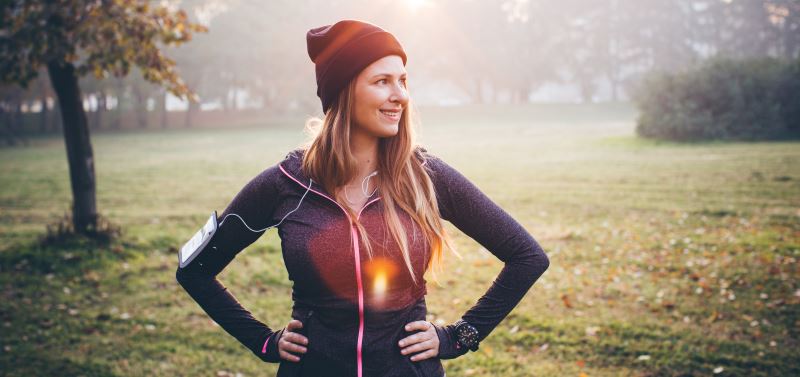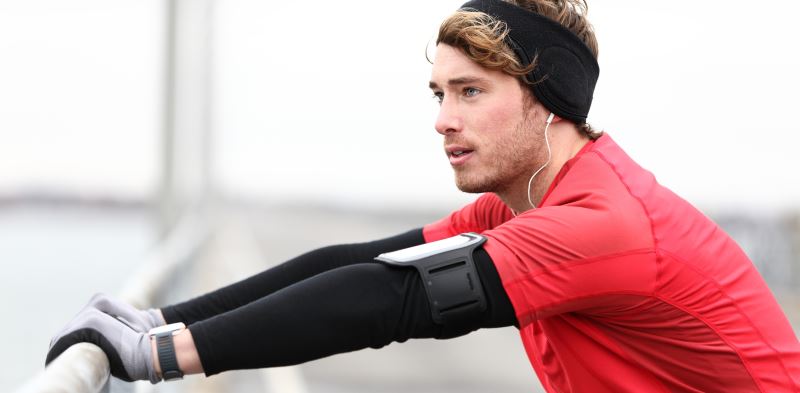Why choose to run outside?
When it’s cold and miserable outside, it can be so tempting to just curl up inside and hibernate all winter. However, getting up and active is a great way to boost energy levels and mood during the dark winter months.
It might sound crazy, but I always encourage people to run outside during the winter. Yes, you heard that right!
So why should you brave the chilly weather and take your runs outside this winter?
Benefit from the fresh air
During the winter we spend a lot of time indoors, sitting in stale, air-conditioned air. This isn’t great for your body as this air is likely to be lower in oxygen and full of cold and flu viruses!
Exercising outdoors helps to circulate fresh, oxygen-rich blood around the body. This improved circulation helps to nourish the whole body, but also helps to mobilise the immune cells, allowing them to scour the body for viruses and bacteria.
In fact, running on forest trails is thought to do more than simply boost circulation and improve fitness. Spending time in forests, also known as forest-bathing or Shinrin-yoku, is thought to have some major health benefits, including lowering blood pressure, improving mood and promoting the immune system. The benefits to the immune system in particular are thought to be the result of the essential oils released by wood and plants called phytoncide.

Avoid the germ-filled gym
In the winter it seems like cold and flu viruses everywhere – in the workplace, on public transport and, yes, in your local gym!
Gyms tend to be full of people in close proximity, using and touching the same pieces of equipment all day. The air conditioning also means that air is often recirculated throughout the building all day, allowing viruses and bacteria to gather.
Get some natural daylight
Our bodies are highly dependent on the natural day and night cycles: as the day brightens, we release serotonin, the hormone that makes us feel lively and happy, and as the light fades, we release melatonin, the sleep hormone. This can get thrown out of balance in the winter as the days are much shorter.
To make matters worse, we tend to spend very little time outside in the natural light during winter – we wake up in the dark, sit at work or at home all day, and then it’s often dark by the time we get home. This can leave us fatigued, and often quite low as we produce too much melatonin.
In fact, Seasonal Affective Disorder is a type of depression only experienced in winter, due to this lack of sunlight and incorrect hormone balance.
If you can squeeze in an afternoon run while it’s still light, your body and mind will really thank you for it! Not only will the fresh air and endorphins energise you but the daylight will remind your body and mind that it should be fully awake.

What to wear when running in cold temperatures
Your usual running gear – leggings or shorts and a t-shirt – will likely not be suitable when the weather drops into single figures. However, your woolly jumpers and ski jackets may not be the answer either!
My advice is to wear layers so that you can strip them off as you warm up during your run. Try pairing a thermal long-sleeved t shirt with a sweater or running jacket – and if it’s really cold you might want to wear all three. Don’t be afraid to wear a hat and gloves too!
Your local running shop will also probably sell specialised running clothes for the winter, including thermal leggings, tops and gloves.

Is it safe to run outside in the winter?
As long as you’re sensible, then yes, it’s perfectly safe!
However, I do have a few pieces of advice to make sure your run is as safe as possible:
- Stick close to home. If the temperatures suddenly plummet or a blizzard appears out of nowhere, you don’t want to be trapped in the middle of nowhere
- Keep an eye on the weather forecast. This is another great way to make sure you don’t get stuck in poor weather
- Stay near busy areas. If you slip on ice and injure yourself, you don’t want to be too far from other people. This could mean running in the city, or in a forest or park that’s popular with dog walkers
- Take it slow. Running in cold weather can be a bit of a shock, and your lungs and throat may not appreciate the icy air at first. Take a few short runs first to get used to it before trying out a 5K
- Don’t forget your reflective clothing! Running in the winter often means running in poor light, so make sure you’re wearing something reflective or even a head-torch if you need.
Want to get started? Read my top 5 tips for running in cold weather.
Originally written on 11/10/2017, updated on 30/10/2018.








